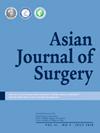Drainless thoracoscopic surgery for primary spontaneous pneumothorax: A propensity-matched study
IF 3.8
3区 医学
Q1 SURGERY
引用次数: 0
Abstract
Objective
Drainless thoracoscopic surgery, which avoids chest drainage after surgery, has been controversial for the treatment of primary spontaneous pneumothorax. This study aimed to demonstrate the postoperative outcomes of drainless thoracoscopic surgery in a select cohort of patients with primary spontaneous pneumothorax.
Methods
This retrospective study enrolled patients who underwent thoracoscopic surgery for primary spontaneous pneumothorax between August 2016 and December 2021 at Far-Eastern Memorial Hospital, New Taipei City, Taiwan. A group of patients was carefully selected from the cohort to undergo a drainless procedure. Clinical characteristics and postoperative outcomes were compared between propensity score-matched patients with and without chest drains.
Results
Among the 198 patients enrolled, 54 and 144 were assigned to the drainless and drain groups, respectively. After propensity score matching, 54 patients in both the groups had similar clinical characteristics. Compared to the drain group, the drainless group had a shorter hospital stay [Median (Interquartile range), 2 (1–2) versus 2 (2–3), p < 0.001] and lesser postoperative pain [1 (0–2) versus 3 (2–3), p < 0.001], but there were no significant between-group differences in postoperative complications [3 (5.55 %) cases in drainless group versus 2 (3.70 %) in drain group, p = 0.480] and disease recurrence [3 (5.56 %) cases in the drainless group versus 5 (9.26 %) in the drain group, p = 0.727].
Conclusion
Drainless thoracoscopic surgery is associated with reduced pain and shorter hospital stay without compromising postoperative outcomes including disease recurrence. Hence, it may be advantageous for a carefully selected cohort of patients with primary spontaneous pneumothorax.
无引流胸腔镜手术治疗原发性自发性气胸:一项倾向匹配研究
目的避免术后胸腔引流的无引流胸腔镜手术治疗原发性自发性气胸一直存在争议。本研究旨在证明无引流胸腔镜手术治疗原发性自发性气胸患者的术后结果。方法本回顾性研究纳入2016年8月至2021年12月在台湾新北市远东纪念医院接受胸腔镜手术治疗原发性自发性气胸的患者。从队列中精心挑选一组患者进行无排水手术。比较倾向评分匹配的有和没有胸腔引流的患者的临床特征和术后结果。结果198例入组患者中,无引流组54例,引流组144例。倾向评分匹配后,两组患者中有54例具有相似的临床特征。排水集团相比,用之不竭的集团有一个更短的住院(中值(四分位范围),2(1 - 2)和2 (2 - 3),p & lt; 0.001)和较小的术后疼痛[1(0 - 2)和3 (2 - 3),p & lt; 0.001],但没有显著差异在术后并发症(3(5.55%)例用之不竭的组与排水组2 (3.70%),p = 0.480)和疾病复发(3(5.56%)例用之不竭的组和5排水组(9.26%),p = 0.727)。结论无引流胸腔镜手术可减轻疼痛,缩短住院时间,且不影响疾病复发等术后预后。因此,对于精心挑选的原发性自发性气胸患者队列可能是有利的。
本文章由计算机程序翻译,如有差异,请以英文原文为准。
求助全文
约1分钟内获得全文
求助全文
来源期刊

Asian Journal of Surgery
医学-外科
CiteScore
3.60
自引率
31.40%
发文量
1589
审稿时长
33 days
期刊介绍:
Asian Journal of Surgery, launched in 1978, is the official peer-reviewed open access journal of the Asian Surgical Association, the Taiwan Robotic Surgery Association, and the Taiwan Society of Coloproctology. The Journal is published monthly by Elsevier and is indexed in SCIE, Medline, ScienceDirect, Scopus, Embase, Current Contents, PubMed, Current Abstracts, BioEngineering Abstracts, SIIC Data Bases, CAB Abstracts, and CAB Health.
ASJSUR has a growing reputation as an important medium for the dissemination of cutting-edge developments in surgery and its related disciplines in the Asia-Pacific region and beyond. Studies on state-of-the-art surgical innovations across the entire spectrum of clinical and experimental surgery are particularly welcome.
The journal publishes original articles, review articles, and case reports that are of exceptional and unique importance. The journal publishes original articles, review articles, and case reports that are of exceptional and unique importance.
 求助内容:
求助内容: 应助结果提醒方式:
应助结果提醒方式:


